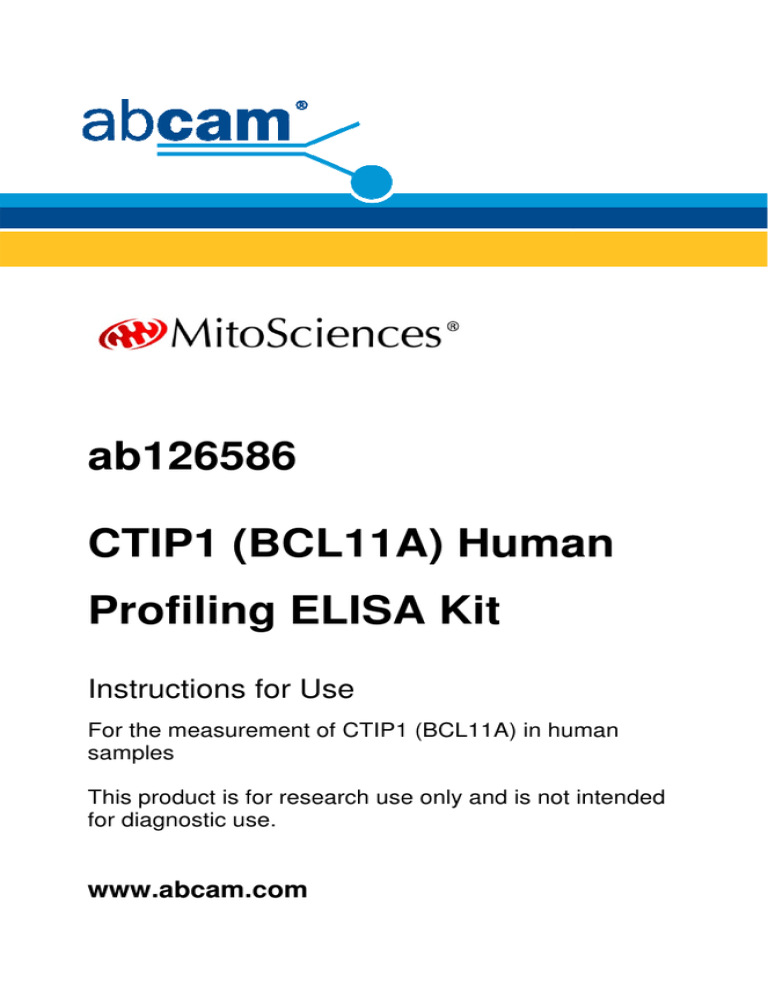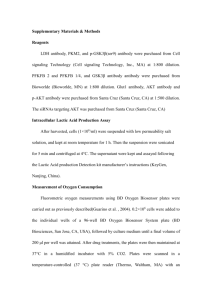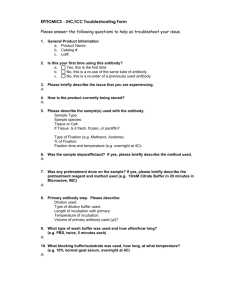ab126586 CTIP1 (BCL11A) Human ) Human
advertisement

ab126586 CTIP1 (BCL11A)) Human Profiling ELISA Kit Instructions for Use For the measurement of CTIP1 (BCL11A) in human samples This product is for research use only and is not intended for diagnostic use. www.abcam.com ab126586 CTIP1 (BCL11A) Human Profiling Kit 1 ab126586 CTIP1 (BCL11A) Human Profiling Kit Table of Contents 1. Introduction 3 2. Assay Summary 5 3. Kit Contents 6 4. Storage and Handling 6 5. Additional Materials Required 7 6. Preparation of Reagents 8 7. Sample Preparation 9 8. Control Sample Dilution Series Preparation 12 9. Assay Procedure 13 10. Data Analysis 16 11. Specificity 18 12. Troubleshooting 21 2 ab126586 CTIP1 (BCL11A) Human Profiling Kit 1. Introduction Principle: ab126586 CTIP1 human ELISA (Enzyme-Linked Immunosorbent Assay) kit is an in vitro assay for the quantitative measurement of human CTIP1 in cell and tissue lysates. The assay employs an antibody specific for human CTIP1 coated onto 96-well plate strips. Samples are pipetted into the wells and the analyte present in the sample is bound to the wells by the immobilized antibody. The wells are washed and an anti-CTIP1 primary detector antibody is added. After washing away unbound primary detector antibody, HRP-conjugated secondary detector antibody specific for the primary detector antibody is pipetted to the wells. The wells are again washed, a TMB substrate solution is added to the wells and color develops in proportion to the amount of analyte bound. The developing blue color is measured at 600 nm. Optionally the reaction can be stopped by adding hydrochloric acid which changes the color from blue to yellow and the intensity can be measured at 450 nm. 3 ab126586 CTIP1 (BCL11A) Human Profiling Kit Background: CTIP1 (encoded by BCL11A or CTIP1 gene) is a C2H2-type zinc finger protein and is closely related to CTIP2. Over expression of these proteins has been linked to B cell malignancies. CTIP1 functions as a myeloid and B-cell proto-oncogene and may play important roles in leukemogenesis and hematopoiesis. CTIP1 is an essential factor in lymphopoiesis, and is required for B-cell formation in fetal liver. CTIP1 may function as a modulator of the transcriptional repression activity of ARP1. 4 ab126586 CTIP1 (BCL11A) Human Profiling Kit 2. Assay Summary Equilibrate all reagents to room temperature. Prepare all the reagents, and samples as instructed. Add 50 µL sample to each well used. Incubate 2 hours at room temperature. Aspirate and wash each well two times. Add 50 µL prepared detector antibody to each well. Incubate 1 hour at room temperature. Aspirate and wash each well two times. Add 50 µL prepared HRP label. Incubate 1 hour at room temperature. Aspirate and wash each well three times. Add 100 µL TMB Development Solution to each well. Immediately record the color development with elapsed time at 600 nm for 15 minutes. Alternatively add a Stop solution at a user-defined time and read at 450 nm. 5 ab126586 CTIP1 (BCL11A) Human Profiling Kit 3. Kit Contents Item Quantity 20X Buffer 20 mL Extraction Buffer 15 mL 10X Blocking Buffer 6 mL TMB Development Solution 12 mL 10X CTIP1 Detector Antibody 1 mL 10X HRP Label 1 mL CTIP1 Microplate (12 x 8 antibody coated well strips) 96 Wells 4. Storage and Handling Store all components at 4°C. This kit is stable for 6 months from receipt. Unused microplate strips should be returned to the pouch containing the desiccant and resealed. 6 ab126586 CTIP1 (BCL11A) Human Profiling Kit 5. Additional Materials Required • Microplate reader capable of measuring absorbance at 600 nm (or 450 nm after addition of Stop solution - not supplied). • Method for determining protein concentration (BCA assay recommended). • Deionized water • Multi and single channel pipettes • PBS (1.4 mM KH2PO4, 8 mM Na2HPO4, 140 mM NaCl, 2.7 mM KCl, pH 7.3) • Tubes for control samplke dilution • Stop solution (optional) – 1N hydrochloric acid • Optional plate shaker for all incubation steps • Well plate cover or seals 7 ab126586 CTIP1 (BCL11A) Human Profiling Kit 6. Preparation of Reagents o 6.1 Equilibrate all reagents to room temperature (18-25 C) prior to use. 6.2 Prepare 1X Wash Buffer by adding 20 mL 20X Buffer to 380 mL nanopure water. Mix gently and thoroughly. 6.3 Prepare 1X Incubation Buffer by adding 6 mL 10X Blocking Buffer to 54 mL 1X Wash Buffer. Unused 1X Incubation buffer may be stored at -20°C for 6 months after performing assay. Mix gently and thoroughly. 6.4 Prepare the 1X CTIP1 Detector Antibody by diluting the 10X CTIP1 Detector Antibody 10-fold with 1X Incubation Buffer immediately prior to use. Prepare 0.5 mL for each 8 well strip used. 6.5 Prepare the 1X HRP label by diluting the stock 10X HRP Label 10-fold with 1X Incubation Buffer immediately before use. Prepare 0.5 mL for each 8 well strip used. 8 ab126586 CTIP1 (BCL11A) Human Profiling Kit 7. Sample Preparation Note: Extraction buffer can be supplemented with phosphatase inhibitors, PMSF and protease inhibitor cocktail prior to use. Supplements should be used according to manufacturer’s instructions. 7.1 Cell lysates. 7.1.1. Collect non adherent cells by centrifugation or scrape to collect adherent cells from the culture flask. Typical centrifugation conditions for cells are o 500 x g for 10 min at 4 C. 7.1.2. Rinse cells twice with PBS. 7.1.3. Solubilize cell pellet at 2x10 /mL in Extraction Buffer. 7.1.4. Incubate on ice for 20 minutes. 7 16,000 x g for 20 minutes at 4°C. Centrifuge at Transfer the supernatants into clean tubes and discard the pellets. Assay samples immediately or aliquot and store at -80°C for 6 months. The sample protein concentration in the extract may be quantified using a protein assay. 9 ab126586 CTIP1 (BCL11A) Human Profiling Kit 7.2 Tissue lysates. 7.2.1. Tissue lysates are typically prepared by homogenization of tissue that is first minced and thoroughly rinsed in PBS to remove blood (dounce homogenizer recommended). 7.2.2. Suspend the homogenate to 25 mg/mL in PBS. 7.2.3. Solubilize the homogenate by adding 4 volumes of Extraction Buffer to a sample concentration of 5 mg/mL. 7.2.4. Incubate on ice for 20 minutes. 16,000 x g, for 20 minutes at 4°C. Centrifuge at Transfer the super-natants into clean tubes and discard the pellets. Assay samples immediately or aliquot and store at -80°C. The sample protein concentration in the extract may be quantified using a protein assay. 7.3 Sub-cellular organelle lysates 7.3.1 Prepare the organelle sample by, for example, subcellular fractionation. 7.3.2 Pellet the sample. 7.3.3 Solubilize the pellet by adding 9 volumes Extraction Buffer. 7.3.4 Incubate on ice for 20 minutes. 16,000 x g for 20 minutes at 4°C. Centrifuge at Transfer the 10 ab126586 CTIP1 (BCL11A) Human Profiling Kit supernatants into clean tubes and discard the pellets. Assay samples immediately or aliquot and store at -80°C. The sample protein concentration in the extract may be quantified using a protein assay. The sample should be diluted to within the working range of the assay in 1X Incubation Buffer. As a guide, typical ranges of sample concentration for commonly used sample types are shown below in Data Analysis. 11 ab126586 CTIP1 (BCL11A) Human Profiling Kit 8. Control Sample Dilution Series Preparation Note: It is strongly recommended to prepare a dilution series of control (normal) material. The relative levels or profile of CTIP1 in unknown samples can be interpolated from within this control sample series. 8.1. To create a dilution series of control sample, label a series of tubes #2-7. Add 150 µL 1X Incubation buffer to each of tubes #2 through #7. 8.2. Prepare all samples by detergent extraction as described. Dilute the control sample lysate to 1 mg/mL in 1X Incubation buffer, label this tube #1. Undiluted control o sample can be frozen at -80 C. 8.3. Transfer 150 µL from tube #1 to tube #2. Mix thoroughly. With a fresh pipette tip transfer 150 µL from #2 to #3. 8.4. Repeat serial dilution as in step 8.3 for Tubes #3 through #7. Use 1X Incubation buffer as the zero sample tube labeled #8. Use a fresh dilution series for each assay. 12 ab126586 CTIP1 (BCL11A) Human Profiling Kit 9. Assay Procedure Equilibrate all reagents and samples to room temperature before use. It is recommended all samples and standards be assayed in duplicate. 9.1. Prepare all reagents, control and unknown samples as directed in the previous sections. 9.2. Remove excess microplate strips from the plate frame, return them to the foil pouch containing the desiccant pack, and reseal. 9.3. Add 50 µL of each diluted sample per well. It is recommended to include a dilution series of a control 13 ab126586 CTIP1 (BCL11A) Human Profiling Kit (normal) sample as a reference. Also include a 1X Incubation buffer as a zero standard. 9.4. Cover/seal the plate and incubate for 2 hours at room temperature. If available use a plate shaker for all incubation steps at 300 rpm. 9.5. Aspirate each well and wash, repeat this once more for a total of two washes. Wash by aspirating or decanting from wells then dispensing 300 µL 1X Wash buffer into each well as described above. Complete removal of liquid at each step is essential to good performance. After the last wash, remove the remaining buffer by aspiration or decanting. Invert the plate and blot it against clean paper towels to remove excess liquid. 9.6. Immediately prior to use prepare sufficient (0.5 mL/strip used) 1X CTIP1 Detector Antibody in 1X Incubation buffer. Add 50 µL 1X CTIP1 Detector antibody to each well used. Cover/seal the plate and incubate for 1 hour at room temperature. If available use a plate shaker for all incubation steps at 300 rpm. 9.7. Repeat the aspirate/wash procedure above. 9.8. Immediately prior to use prepare sufficient (0.5 mL/strip used) 1X HRP label in 1X Incubation buffer. Add 50 µL 14 ab126586 CTIP1 (BCL11A) Human Profiling Kit 1X HRP label to each well used. Cover/seal the plate and incubate for 1 hour at room temperature. If available use a plate shaker for all incubation steps at 300 rpm. 9.9. Repeat the aspirate/wash procedure above, however, performing a total of three washes. 9.10. Add 100 µL TMB Development Solution to each empty well and immediately record the blue color development with elapsed time in the microplate reader prepared with the following settings: Mode: Wavelength: Time: Interval: Shaking: Kinetic 600 nm up to 15 min. 20 sec. - 1 min. Shake between readings Alternative– In place of a kinetic reading, at a user defined, time record the endpoint OD data at (i) 600 nm or (ii) stop the reaction by adding 100 µL stop solution (1N HCl) to each well and record the OD at 450 nm. 9.11. Analyze the data as described below. 15 ab126586 CTIP1 (BCL11A) Human Profiling Kit 10. Data Analysis Average the duplicate control sample dilution series readings and plot against their concentrations after subtracting the zero standard reading. Draw the best smooth curve through these points to construct a standard curve. Most plate reader software or graphing software can plot these values and curve fit. A four parameter algorithm (4PL) usually provides the best fit, though other equations can be examined to see which provides the most accurate (e.g. linear, semi-log, log/log, 4 parameter logistic). Read the relative CTIP1 concentrations for unknown samples from the control curve plotted. Samples producing signals greater than that of the highest control should be further diluted in 1X Incubation buffer and reanalyzed, then multiplying the concentration found by the appropriate dilution factor. 16 ab126586 CTIP1 (BCL11A) Human Profiling Kit TYPICAL SAMPLE RANGE - For demonstration only. mOD/min 600 nm 100 10 1 0.1 0.001 0.01 0.1 1 10 Hek293 extract (mg/mL) Figure 1. Example control sample curve. TYPICAL SAMPLE RANGE Typical working ranges for cell and tissue extracts Sample Type Range Cultured cell lysates (Hek293T/Jurkat) 0.03 – 2 mg/mL Other cultured lysates (HeLa, HepG2, fibroblasts) 0 SENSITIVITY Determined minimum detectable dose: 30 µg/mL for cultured whole cell lysates e.g. Hek293T 17 ab126586 CTIP1 (BCL11A) Human Profiling Kit REPRODUCIBILITY Calculated by comparing an unknown with a dilution series of a standard normal cell lysates. Parameter CV% Intra (n=8, average of 3 days) 5.7 Inter (n=3) 4.1 11. Specificity SPECIFICITY Species– human. Mouse predicted, other species are untested. The capture antibody used in this kit is available as individual antibody ab19487. Several extracts from cultured human, rat and mouse cell lines were assessed for CTIP1 content using this kit. Jurkat and Hek293T cell lysates showed significant levels of CTIP1 and levels were similar (see Figure 2). These relative levels were confirmed in Western blotting using the capture antibody (Figure 3) and also by the detector antibody (data not shown). 18 ab126586 CTIP1 (BCL11A) Human Profiling Kit mOD/min (600nm) 50 40 30 20 10 0 HeLa C6 MEF HDFn Jurkat Hek293T Figure 2. CTIP1 expression levels are compared between several cultured cell lines. Only extracts from Jurkat cells (immortalized human T lymphocyte) and Hek293T (immortalized human embryonic kidney cell line) showed significant CTIP1 expression levels. Cell lines HeLa (human), C6 (rat glioma), MEF (mouse embryonic fibroblasts) and HDFn (neonatal human dermal fibroblasts) showed no or significantly lower CTIP1 expression levels. 19 ab126586 CTIP1 (BCL11A) Human Profiling Kit Figure 3. The relative expression levels of CTIP1 measured by ELISA were confirmed by Western blotting using the detector antibody (ab19487). 20 µg of each sample type was analyzed. The CTIP1 protein band is indicated at 92 kDa. This antibody also identified a 55 kDa protein band in Western blotting, principally in mouse fibroblasts (MEF), but this is unrelated to CTIP1 and does not interfere with this ELISA as demonstrated by lack of any signal in MEF sample. 20 ab126586 CTIP1 (BCL11A) Human Profiling Kit 12. Troubleshooting Problem Cause Low CTIP1 concentration in sample Low Signal Large CV Low sensitivity Incubation times too brief Solution Use appropriate positive control. Human Jurkat cultured cells are recommended. Ensure sufficient incubation times; change to overnight standard/sample incubation Inadequate reagent volumes or improper dilution Check pipettes and ensure correct preparation Plate is insufficiently washed Review manual for proper wash technique. If using a plate washer, check all ports for obstructions Contaminated wash buffer Make fresh wash buffer Improper storage of the ELISA kit Store assay components 4°C. Keep substrate solution protected from light 21 ab126586 CTIP1 (BCL11A) Human Profiling Kit 22 ab126586 CTIP1 (BCL11A) Human Profiling Kit Abcam in the USA Abcam Inc 1 Kendall Square, Ste B2304 Cambridge, MA 02139-1517 USA Toll free: 888-77-ABCAM (22226) Fax: 866-739-9884 Abcam in Europe Abcam plc 330 Cambridge Science Park Cambridge CB4 0FL UK Tel: +44 (0)1223 696000 Fax: +44 (0)1223 771600 Abcam in Japan Abcam KK 2-2-1 Nihonbashi Horidome-cho, Chuo-ku, Tokyo 103-0012 Japan Tel: +81-(0)3-6231-0940 Fax: +81-(0)3-6231-0941 Abcam in Hong Kong Abcam (Hong Kong) Ltd Unit 712, 7th Floor, Lakeside 1, No. 8 Science Park West Ave, Hong Kong Science Park, Pak Shek Kok, New Territories, Hong Kong Tel: (852) 2603-6823 Fax: (852) 3016-1888 23 Copyright © 2011 Abcam, All Rights Reserved. The Abcam logo is a registered trademark. All information / detail is correct at time of going to print.






